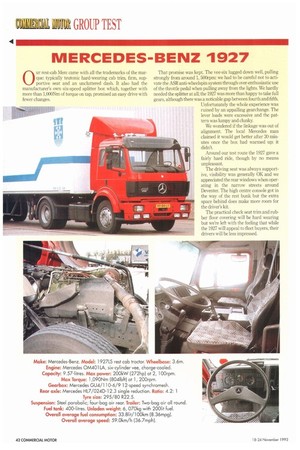MERCEDES-BENZ 1927
Page 44

If you've noticed an error in this article please click here to report it so we can fix it.
0 ur rest-cab Merc came with all the trademarks of the marque: typically teutonic hard-wearing cab trim, firm, supportive seat and an uncluttered dash. It also had the manufacturer's own six-speed splitter box which, together with more than 1,000Nm of torque on tap, promised an easy drive with fewer changes.
That promise was kept. The vee-six lugged down well, pulling strongly from around 1, 500rpm: we had to be careful not to activate the ASR anti-wheelspin system through over-enthusiastic use of the throttle pedal when pulling away from the lights. We hardly needed the splitter at all; the 1927 was more than happy to take full gears, although there was a noticable gap between fourth and fifth. Unfortunately the whole experience was ruined by an appalling gearchange. The lever loads were excessive and the pattern was lumpy and clunky.
We wondered if the linkage was out of alignment. The local Mercedes man claimed it would get better after 30 minutes once the box had warmed up: it didn't.
Around our test route the 1927 gave a fairly hard ride, though by no means unpleasant.
The driving seat was always supportive, visibility was generally OK and we appreciated the rear windows when operating in the narrow streets around Deventer. The high centre console got in the way of the rest bunk but the extra space behind does make more room for the driver's kit.
The practical check seat trim and rubber floor covering will be hard wearing but we're left with the feeling that while the 1927 will appeal to fleet buyers, their drivers will be less impressed.




















































































































